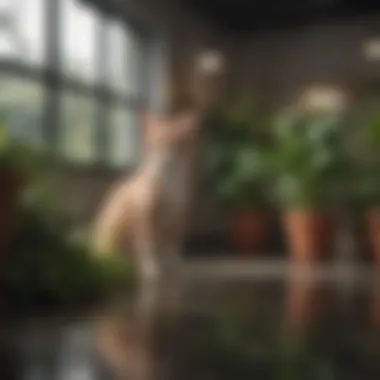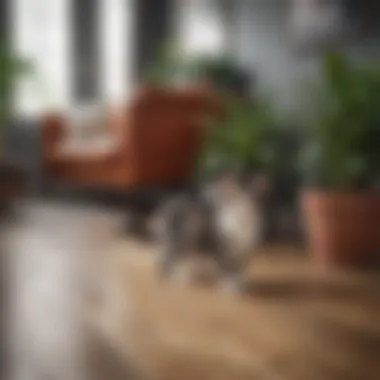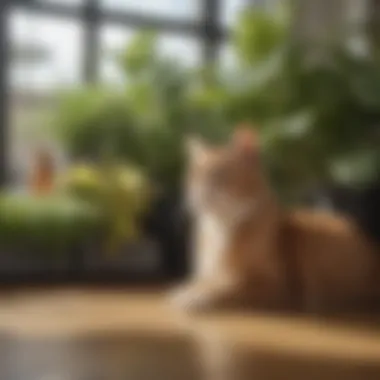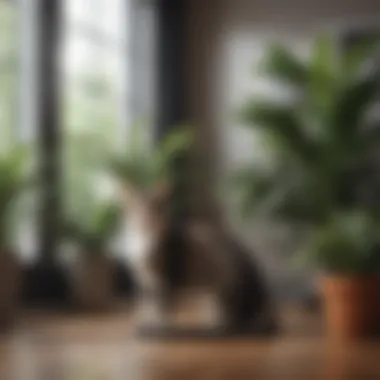Cat Friendly Floor Plants: An In-Depth Guide


Intro
Incorporating plants into our homes can transform the atmosphere, providing a sense of tranquility and connection to nature. However, for cat owners, selecting plants that are safe for their feline companions is a crucial aspect of this endeavor. Cats are naturally curious creatures, often drawn to the foliage of plants in their environment. Unfortunately, many common houseplants can pose serious health risks to them. This guide will explore the essential factors for selecting cat-friendly floor plants, presenting a comprehensive overview of safe varieties and their care requirements.
Understanding which plants are safe can alleviate the anxiety many cat owners face when deciding to introduce greenery into their interiors. Whether you are aiming to enhance your living space or create a nurturing environment for your pet, the information provided here will assist you in making informed decisions about plant choices.
Benefits of Floor Plants for Your Home
Adding floor plants to your indoor areas not only beautifies the space but also purifies the air and improves your mental well-being. Studies suggest that plants can help reduce stress and anxiety, create a more pleasant atmosphere, and even increase productivity. When those plants are also safe for cats, you gain the added advantage of a harmonious environment.
Content Overview
This article will cover a range of topics, including:
- A detailed list of cat-friendly floor plants
- Essential care tips for maintaining these plants
- Recommendations for creating a cat-friendly environment
- Challenges that may arise in homes with cats and how to mitigate them
Through this exploration, we hope to equip you with the knowledge needed to foster a vibrant and safe living space.
Design Inspiration
In the world of interior design, plants have increasingly become a focal point. They serve as both decor and a means of promoting health. Current trends reflect a growing appreciation for biophilic design—the idea of connecting nature to architecture.
Current Interior Design Trends
Modern design places emphasis on natural materials, minimalism, and the infusion of liveliness within spaces. Integrating cat-friendly floor plants aligns perfectly with these trends. Popular options include:
- Fiddle Leaf Fig: Known for its large leaves and dramatic presence.
- Areca Palm: Adds a tropical touch and is highly cat-safe.
- Spider Plant: Easy to care for and non-toxic to cats.
Color Palettes and Their Effects
The choice of plants can also influence color palettes within your home. Green shades promote calmness and serve as a neutral backdrop for brighter accents. Soft earth tones combined with green can enhance warmth in a room. Creating a balanced aesthetic through thoughtful plant selection fosters a serene environment conducive to both human and animal well-being.
"Incorporating plants into your home is not just an aesthetic choice; it's a commitment to enhancing your well-being and that of your pets."
By aligning your plant selection with current design inspirations, you ensure a stylish yet safe living environment.
Prolusion to Cat Friendly Floor Plants
Indoor plants can greatly enhance the aesthetic of any home. However, for cat owners, the task becomes quite complex. The selection of floor plants must be carefully considered to ensure the safety of the feline roommates. Not all plants are safe for cats, which is why understanding the characteristics of cat-friendly options is crucial. This part of the article serves as an in-depth guide to help those who love plants and want to keep their cats safe.
Understanding the Risks for Cats
When considering indoor flora, one must acknowledge the risks linked with various plants. Many common houseplants, such as lilies and philodendrons, can be toxic to cats. These toxic plants can lead to symptoms ranging from mild discomfort like vomiting to severe consequences such as organ failure. This highlights the importance of identifying safe varieties.
To prevent such risks, research is vital. Cat owners should be aware of their plant choices. Read labels, consult trusted resources, or refer to platforms like Wikipedia for lists of plants that are known to be harmful to pets. Always remember that even non-toxic plants can pose risks if consumed in large quantities, further complicating plant selection.
The Appeal of Indoor Plants
Despite the risks, the appeal of indoor plants cannot be overstated. Indoor plants provide numerous benefits, enhancing air quality and helping to create a calming atmosphere. Studies indicate that greenery can reduce stress and improve mental well-being. For homeowners, incorporating plants can transform living spaces into vibrant sanctuaries.


Moreover, many plant varieties exhibit a diverse range of colors and textures, allowing for creative interior design. The aesthetic can complement various styles, from modern minimalism to rustic charm. Indoor plants forge a connection to nature, which can be particularly rejuvenating in urban environments where natural green spaces may be scarce.
Overall, the benefits of indoor plants, paired with catering to a cat-friendly environment, can lead to a harmonious home that fulfills both aesthetic desires and pet safety needs.
Essential Characteristics of Safe Plants
Choosing the right plants for a home with cats goes beyond aesthetics. It is essential to identify characteristics that promote safety and compatibility with feline companions. The primary consideration is ensuring that the selected plants are non-toxic to cats, as some common houseplants can be dangerous if ingested. This understanding serves as the foundation for selecting plants that can coexist harmoniously with your furry friends.
In addition to toxicity, the durability and maintenance needs of the plants also play a significant role in the decision-making process. Cat owners often face challenges associated with curious pets that love to explore and sometimes chew on houseplants. Therefore, selecting resilient plants that can withstand some level of destruction can save time, effort, and money while keeping your home full of greenery.
By focusing on these essential characteristics, cat owners can create an environment that is not only visually appealing but also respects the safety and well-being of their pets.
Non-Toxic Varieties
When selecting plants, the safety of the varieties must be prioritized. Many popular indoor plants may pose risks to cats, leading to health issues if they consume parts of the plant. Non-toxic plants provide peace of mind, allowing cat owners to choose greenery without fear of negative consequences.
Some reliable non-toxic varieties include:
- Spider Plant: Renowned for its air-purifying qualities, it boasts a robust growth pattern and is also safe for cats.
- Boston Fern: This lush plant not only thrives indoors but is also safe for your feline companions.
- Bamboo Palm: Not just aesthetically pleasing, this plant supports indoor air quality and is non-toxic.
- Areca Palm: Known for its feathery fronds, it brings a tropical feel to any space without posing risks to pets.
- Parlor Palm and Calathea: Both are known for their attractive foliage and lack of toxic properties, making them ideal for homes with cats.
By selecting from these non-toxic varieties, homeowners can indulge in the joys of indoor plants while ensuring the safety of their pets.
Durability and Maintenance Needs
Beyond toxicity, durability and maintenance needs of plants should be taken into account. Cats often display destructive behavior as they explore their environments. Therefore, choosing plants that can withstand such interaction is vital.
Resilient plants that can endure occasional nibbles or knocks help maintain a harmonious living space. Some factors to consider include:
- Growth Rate: Look for plants that grow vigorously. Faster-growing species can repair damage more quickly, providing a longer-lasting display of greenery.
- Leaf Structure: Plants with tougher leaves tend to withstand feline curiosity better than those with delicate, easily damaged foliage.
- Water Requirements: Low-maintenance plants that necessitate infrequent watering are a good choice for busy cat owners, reducing the risk of neglect that could lead to plant deterioration.
Top Cat Friendly Floor Plants
Selecting cat friendly floor plants is essential for any homeowner who wishes to incorporate greenery without jeopardizing the safety of their feline companions. Indoor plants can enhance the aesthetic appeal of living spaces while also improving air quality. However, many plants can pose risks to cats if they are toxic or harmful in any way. This section outlines some of the best floor plants that are safe for cats, detailing their characteristics, benefits, and care needs.
Spider Plant
The Spider Plant is a popular choice among cat owners. It is known for its resilience and ease of care. This plant thrives in indirect sunlight and requires minimal water, making it suitable for various indoor environments. The long, arching leaves can be quite appealing to curious cats. Notably, Spider Plants are non-toxic to cats, which allows them to explore the plant safely.
Boston Fern
Boston Ferns are an excellent addition to homes with pets. They enjoy humidity and do well in shaded areas, making them perfect for bathrooms or kitchens. Their lush, feathery fronds offer a unique texture that can entice cats, yet they pose no health risks. Proper watering is key, as they prefer consistently moist soil. This plant can be beneficial for air purification.
Bamboo Palm
The Bamboo Palm, also known as the Chamaedorea, excels in low-light conditions. It grows tall and bushy, providing an attractive display. This palm is cat-friendly and serves as a great humidity booster. Bamboo Palms are also great for removing indoor air pollutants. The foliage is not only safe for cats but also adds a tropical touch to your home.
Areca Palm
Areca Palms are another popular choice for indoor gardening. They can grow quite large, creating an eye-catching focal point. Non-toxic to cats, Areca Palms thrive in bright, indirect light and require regular watering. Each frond presents a gentle sway, which can amuse curious cats without posing any threat to their well-being. Furthermore, they are effective in improving indoor air quality.


Parlor Palm
Parlor Palm is a classic indoor plant known for its elegance and durability. It can adapt to low-light environments, making it versatile for various living spaces. This palm does not harm pets, allowing them to be near it freely. It has a slow growth rate and requires minimal maintenance, which makes it beneficial for busy homeowners.
Calathea
Calathea plants, with their striking patterned leaves, are sure to enhance any interior. While they require more care in terms of humidity and proper watering, they are non-toxic to cats. Calathea thrives in lower light conditions, which can make them perfect for cozy corners. They also contribute to creating a serene and vibrant atmosphere in the home.
In summary, when selecting cat friendly floor plants, homeowners should consider factors such as toxicity and care requirements. The plants mentioned above are not only appealing but also safe for cats, ensuring that your home remains a harmonious environment for both humans and pets.
"Choosing the right plants is critical for maintaining both aesthetics and safety in the home."
By including these plants in your living space, you can enjoy the benefits of greenery without compromising your pet's safety.
Plant Care for Cat Owners
Taking care of plants in a home with cats requires specific knowledge and attention. This section addresses the essential aspects of plant care that cat owners must consider. Though many plants are safe for cats, how we care for these plants can impact their health. This section will examine key factors: watering requirements, light conditions, and fertilization needs. By mastering these elements, cat owners can enhance their indoor spaces while ensuring a safe environment for their pets.
Watering Requirements
Watering is crucial in keeping plants healthy. Each plant has its own water needs that vary by species. For instance, the Spider Plant prefers to dry out between waterings, while Boston Ferns require more moisture. Overwatering can lead to root rot, while underwatering can cause wilting.
To determine when to water your plants:
- Check the soil: Stick your finger into the soil. If it feels dry an inch down, it is time to water.
- Observe the leaves: Yellowing leaves may indicate overwatering, while brown edges can suggest underwatering.
Setting a consistent schedule may help, but always adapt to your plant's response.
Light Conditions
Light exposure plays a significant role in the health of houseplants. Each type of plant has specific light requirements. For instance, Areca Palms thrive in bright, indirect light, while Calathea prefers low light. Understanding these needs helps avoid stunted growth or even plant failure.
Consider these tips for managing light conditions:
- Observe natural light patterns: Determine which spots in your home receive direct sunlight, partial shade, or indirect light throughout the day.
- Rotate plants regularly: This ensures all sides receive light, promoting even growth.
- Use grow lights if necessary: If your space has limited natural light, consider adding grow lights to support plant photosynthesis.
Fertilization and Soil Needs
Fertilization is important in providing essential nutrients to plants, but excessive use can be harmful. Safe plants should be fertilized based on their specific needs. For example, watering the plants with diluted liquid fertilizer during the growing season may benefit them.
Regarding soil, a well-draining potting mix is key. The following considerations are helpful:
- Use organic fertilizers: They tend to be safer for pets.
- Opt for a suitable soil mix: Consider using a cactus mix for plants that prefer drier conditions or a peat-based mix for those needing moisture retention.
Plants not only add beauty but also improve air quality. Taking the time to understand their specific care needs allows cat owners to enjoy greenery and ensure their pets’ safety.
Creating a Cat-Friendly Environment
A cat-friendly environment prioritizes the safety and well-being of your feline companion while allowing you to enjoy the benefits of indoor greenery. This section outlines the important aspects of crafting such an environment. It is crucial to create a balance between aesthetic appeal and safety, ensuring both plants and pets coexist comfortably. When plants are strategically placed and cared for, they can provide your home with beauty without compromising your cat's health.


Strategic Placement of Plants
The location of your plants can significantly affect both the plants and your cats. Keeping plants out of reach from curious paws is a primary step in maintaining a safe environment. High shelves or hanging pots can deter cats from nibbling on leaves. Using sturdier plant stands to elevate your plants is also effective. Moreover, consider the natural behavior of cats; they are drawn to areas where they can observe their surroundings. Placing plants in spots that offer privacy can help minimize any undesired attention they receive from curious felines.
- High Elevation: Use shelves or wall-mounted planters to keep plants safe.
- Private Corners: Position plants away from high-traffic areas to reduce anxiety.
- Observation Points: Choose spots that allow your cat to monitor activities from a distance.
Designing Vertical Spaces
Vertical gardening is beneficial not only for space management but also for engaging cats. By creating vertical spaces, you can offer climbing opportunities for your pets. Shelves that extend upwards can act as climbing structures. This allows cats to explore while ensuring their surroundings remain safe. Incorporating vertical elements in your design adds depth to your home and variety in stimulation for your cat. Plants such as climbing vines can be utilized here, ensuring their safety at every level.
- Shelves for Climbing: Cats enjoy heights; make use of shelves for plants and safe exploration.
- Integrated Planters: Combine pots with cat trees or climbing spaces, ensuring stability.
Providing Alternatives for Play
Cats need stimulation and engagement. Providing alternative options for play can help divert their attention from plants. Interactive toys, scratching posts, and climbing structures keep cats entertained and absorb their natural curiosity. When a cat is tired or engaged elsewhere, they are less likely to view plants as toys. Additionally, incorporating cat grass can serve as both a plant and a designated play item, fulfilling their need to chew while keeping the safety of your main plants intact.
- Toys and Scratching Posts: Keep different varieties to cater to diverse preferences.
- Designated Plant Options: Offering cat grass can dissuade them from targeting decorative plants.
Creating a cat-friendly environment is not just about having the right plants, but also about how you position them and what alternatives you provide for your pet.
In summary, cultivating a space that embraces both plants and cats requires thoughtfulness and attention to detail. By strategically placing plants, utilizing vertical spaces, and providing a variety of play options, you can create an environment that promotes the health and happiness of both your plants and your feline friends.
Addressing Common Challenges
When incorporating floor plants into homes that house feline companions, one must confront several challenges. Understanding these challenges is crucial for maintaining a thriving indoor environment. Firstly, preventing damage to plants is necessary; cats can be curious and playful, making plants at risk of being uprooted or chewed. Secondly, addressing potential allergies in cats is vital. Some plant species may trigger allergic reactions, impacting your cat's health and overall well-being. Both factors not only affect your greenery but also ensure the comfort and safety of your pet.
Preventing Plant Damage
Keeping plants safe from feline mischief can require creativity and vigilance. Here are various approaches to consider:
- Use Tall Stands: Placing plants on high shelves or using tall plant stands can keep them out of reach.
- Plant Barriers: Utilize decorative, yet functional, barriers such as wire mesh or decorative rocks in pots to deter cats from accessing the plants.
- Repellent Scents: Certain smells, such as citrus, can deter cats. Spraying a diluted citrus solution around the pots may help keep cats at bay.
- Sturdy Containers: Selecting heavy or stable pots can reduce the risk of tipping. Consider ceramic or stone pots, as they are generally more robust than plastic ones.
Preventative measures can significantly diminish the risk of plant damage in a multi-pet household.
Addressing Allergies in Cats
Cat owners must be mindful of allergies that could stem from specific plants. Cats, like humans, can develop sensitivities over time. Here are several key points to keep in mind:
- Research Symptoms: Common signs that a cat may have allergies include frequent sneezing, itching, and unusual grooming behaviour. If observed, consult with a veterinarian for proper diagnostics.
- Select Non-Allergenic Plants: Choose varieties known for being hypoallergenic, such as spider plants or bamboo palms. This can greatly minimize allergic reactions.
- Regular Vet Check-ups: Consistent veterinary care not only benefits your cat's overall health but also helps identify any potential allergies early on.
"It is crucial to observe your pet when introducing new plants into the household."
Being vigilant about allergies ensures a sustainable relationship between your plants and pet, promoting wellness for both.
In summary, addressing these common challenges is essential for creating a harmonious living space. By taking preventative actions against plant damage and recognizing allergy symptoms, you can enjoy the beauty of indoor greenery while prioritizing your cat's health.
Closure
The conclusion serves as a pivotal summary of the discussions surrounding cat-friendly floor plants. It encapsulates the essential points that were covered, reinforcing the understanding that safeguarding our feline companions while beautifying our living spaces is both achievable and beneficial. This article has delved deeply into numerous aspects, from identifying non-toxic varieties to implementing care strategies that respect both plants and pets.
Recap of Key Considerations
- Safety First: Choosing plants that are safe for cats is paramount. Non-toxic options like the Spider Plant and Calathea ensure that feline curiosity does not lead to harmful consequences.
- Maintenance Matters: Understanding the care requirements of these plants helps in maintaining their longevity and health. Regular watering, light adjustments, and soil selection are critical components of plant care that should not be overlooked.
- Creating Space: Strategically placing plants in a manner that considers both aesthetics and cat behavior enhances the overall environment. Design choices should promote harmony and prevent any disturbances to the plants or the pets.
Final Thoughts on Indoor Greenery
Incorporating greenery into your home transcends mere decoration. The presence of floor plants can improve air quality and enhance well-being. However, the key is to strike a balance between aesthetic interests and the safety of your pets. Planning your indoor garden with a focus on cat-friendly varieties benefits both the homeowner and their pets. This approach allows for a lush, inviting space, where both the greenery thrives and the feline inhabitants remain safe and healthy.















